
In my work I deal with social meetings between the viewer and the figures in the pictures, whereby the space in which they find themselves plays an essential role. It mostly shows meetings that took place in my environment or self-images in such situations. Consumption is often a side companion, precisely because (communal) cooking, eating and drinking are social interactions that are an important part of life.
Adrian Schär, Heroin, 2021, Photography: Studio Seghrouchni, © Studio Seghrouchni and Studio Adrian Schär
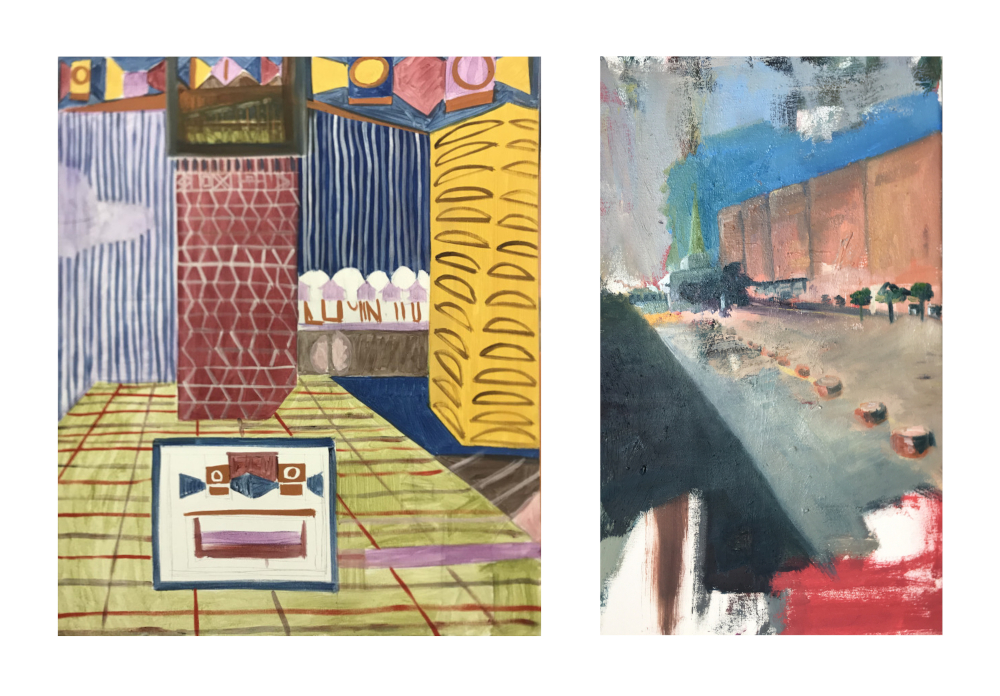
Josephine and Alexandra want to work together.
Designing (exhibition) spaces in which the described similarities and differences arising from the painterly examination can be made visible. At first glance, images that appear to be completely different, contrasting with each other in terms of their shape and color, are to be staged with the help of spatial design options based on physical proximity and distance in their common origin, common questions and investigations of the artists, and yet in their diversity. The confrontation with their environment, which is behind the painting process of the two artists, should become more visible in this way than when looking at one of the two artistic positions individually.
Josephine Jannack: Digitales Ich, 2021, Photography: Josephine Jannack, © Josephine Jannack
Alexandra Ellerbrock: OT47, 2019, Photography: Alexandra Ellerbrock, © Alexandra Ellerbrock

Pop Art is a still photo from the "Back to (my) Normal" series of the Terrace Project which is based on the subconscious drive, spontaneity and unpredictable action. It is mostly art for art, play for play with Document ID: 0b49bf99-3d52-4cfa-8752-6232a66d698c colours, music, motion and surprise. The inspiration comes from Andy Warhol’s homonym art movement.
Alkistis Voulgari, Pop Art, 2021, Photography: Alkistis Voulgari, © Alkistis Voulgari
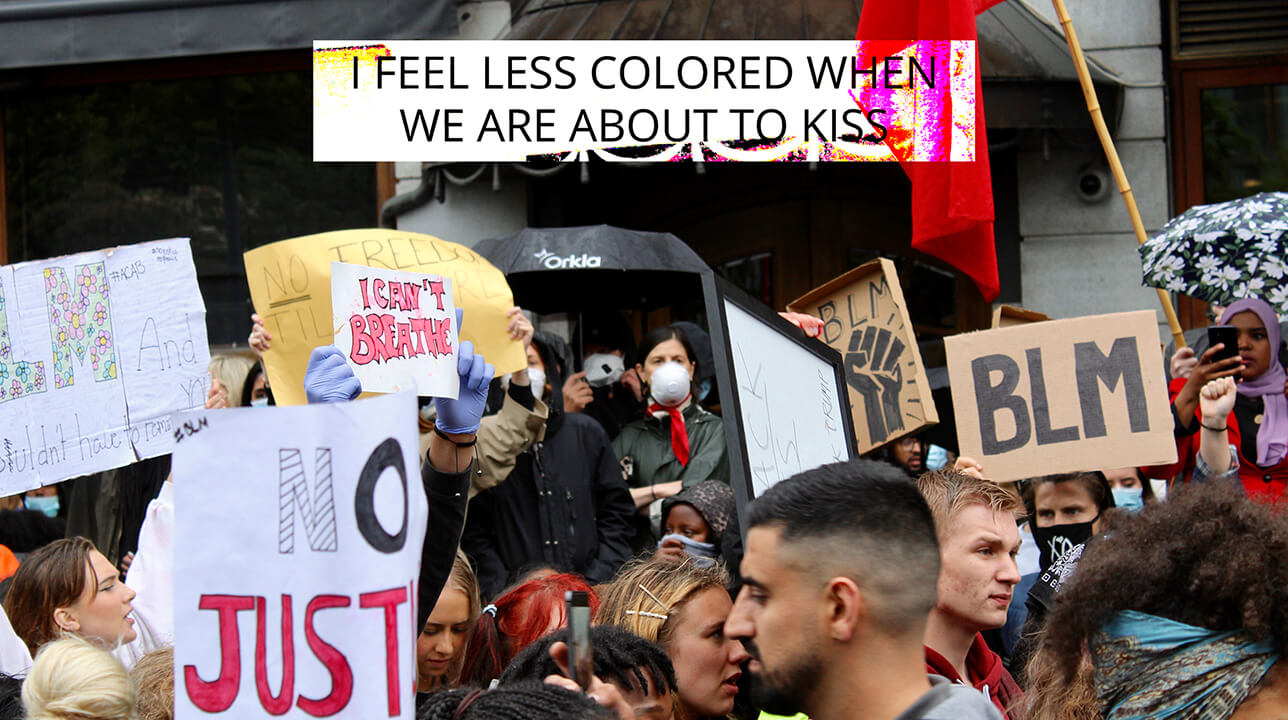
Community means lifting each other up in times of crisis. A peaceful protest is a form of social community that empowers and connects people and helps them discover the common ground they share. This photo takes you with me to the peaceful BLM protest. Karl Johan, one of the busiest streets in the capital of Norway was full of people, uniting their voices for justice and equality.
ALNNOU, ABOUT TO KISS, 2020, Photography: ALNNOU, © ALNNOU

In between the last two years, I collected a wide range of screenshot during zoom sessions. I got interested in this very unique expression on screen, which we leave when we try to get / give a feeling of presence to the others and our self. While sharing a social situation, I found myself looking at myself quite often, being oddly fascinated about my digital opposite. There is something very different from seeing yourself in the mirror while being alone, when now suddenly you realize that your reflection is pixilated, delayed and filtered by a program, which aims to connect you with others. When the digital mirror becomes transparent, you start to interact with the computer as if it be not only your communication-tool but also an entity that takes part in these social events we’re in. Break out room is a collage made out of selected screenrecordings /-shots of myself, taken from calls I took part in and is being framed by the desktop app zoom.
Andrea Fortmann, break out room, 2021, Photography: Andrea Fortmann, © Andrea Fortmann

These are very tough times. We have been locked all day looking through the windows. We have shared fears and hopes. Now, it's time to open the doors and get out, it's time to start again.
Antoni Hidalgo (inercies), about home, 2015, © inercies
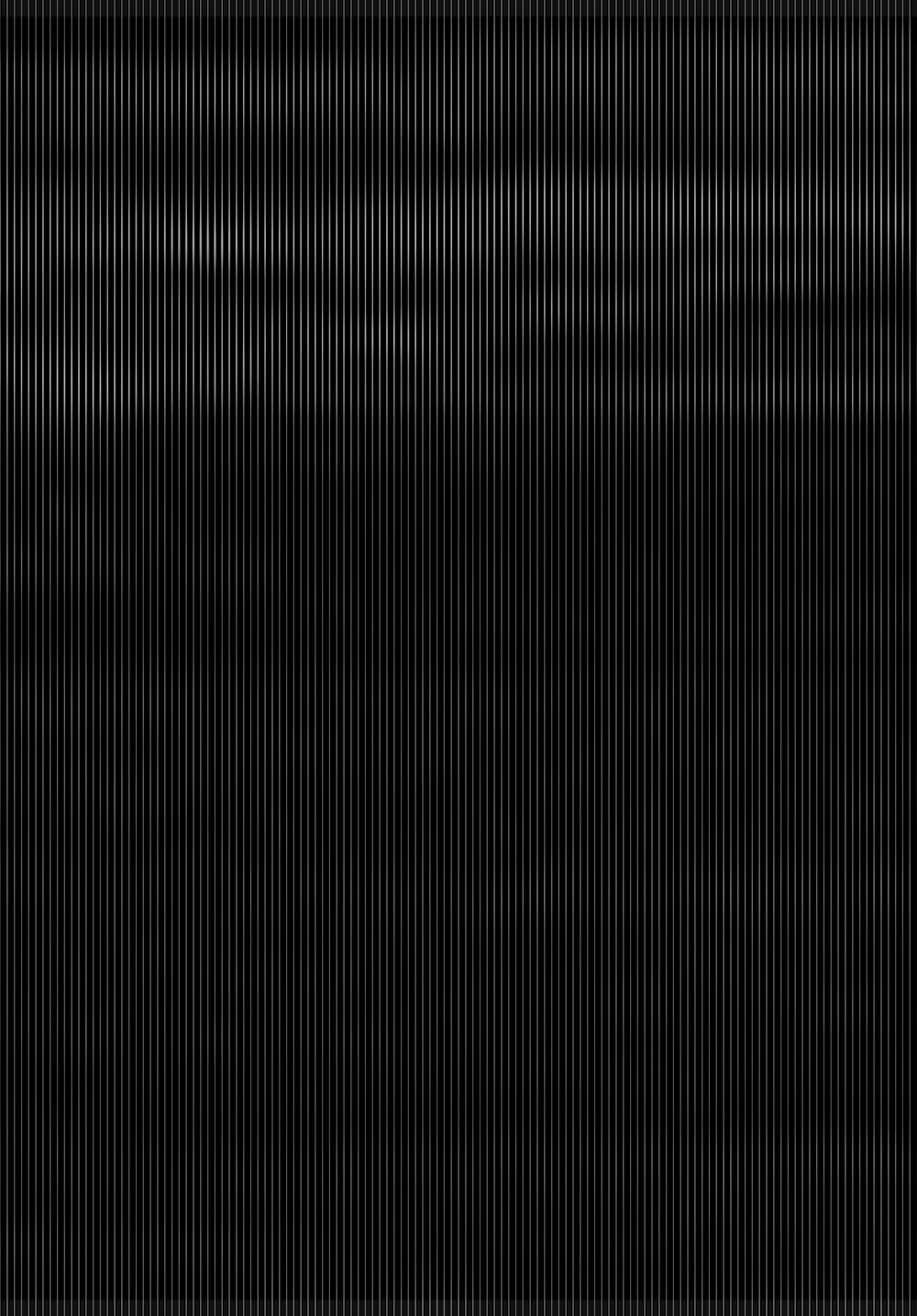
Carin Iko (Karina Petrova) is an artist from St. Petersburg, currently living in Moscow. She works with photography as a material and source for the study of communication, perceptions of the time and transitional states.
Carin Iko, +punkt, 2020, Photography: Carin Iko, © Carin Iko
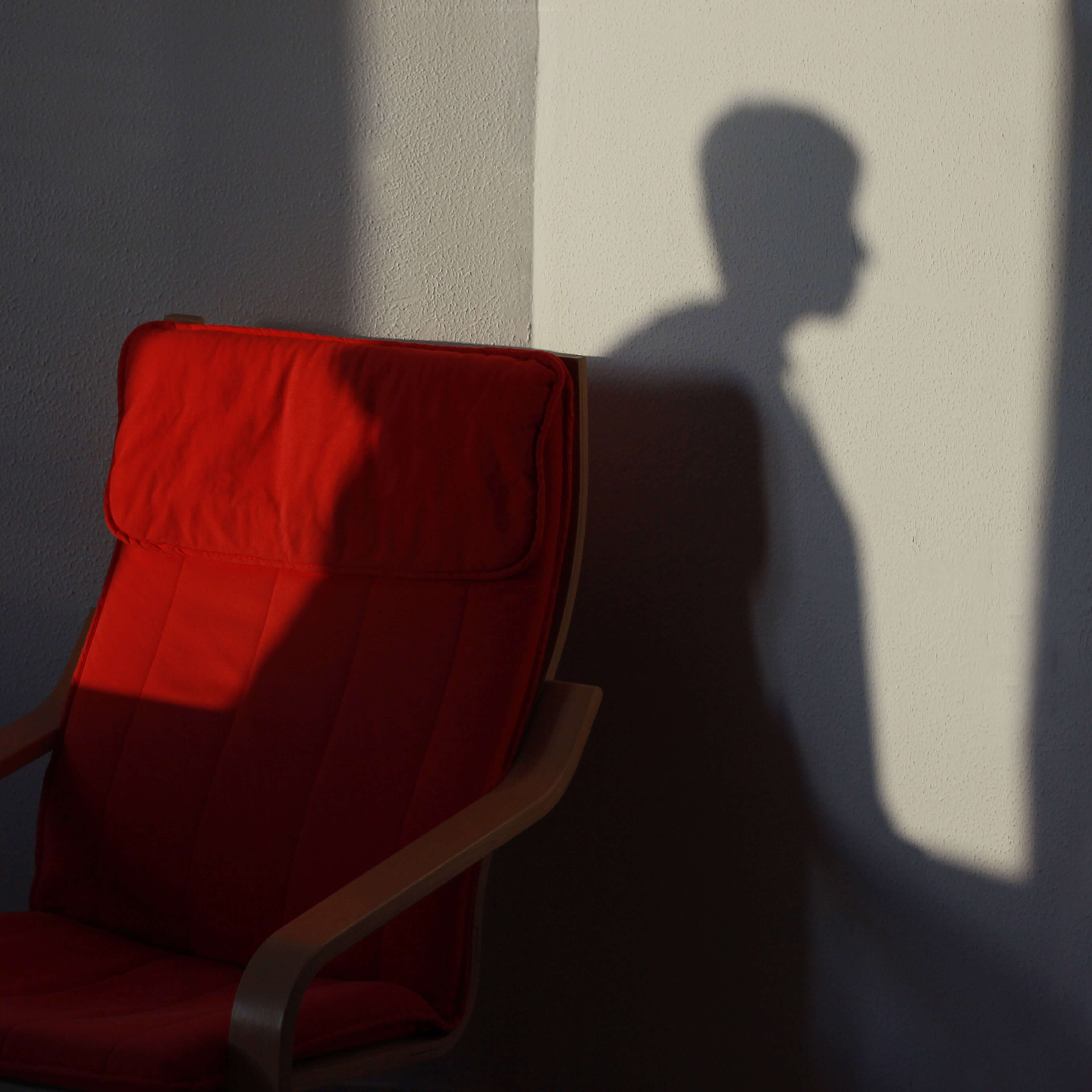
Through her photographs, Celeste Fernandez shows how the construction of human identity has been radically shaped by contemporary globalisation. Each social media plataform is influenced by certain parameters, which means that their users have to dose the information they choose to share, that is to say, the content of their publications will vary drastically; the way they express their ideas and speak, their behaviour with /Statement/ other users, the way they dress and show themselves in photographs, and so on. After all, we have turned Social Networks into a theatre; and the Google search rectangle could be equivalent to the backstage, since it is there that we put on the costume of the character we are going to play, it is there that we decide the stage we are going to enter. One of the main reasons for reflection are the limits created by applications, those that we set ourselves by assigning ourselves certain roles or imposing ourselves to follow the rhythm that globalised society imposes on us, and on what is seen within the framework, but, above all, on what is not seen. The way in which we construct ourselves as individuals nowadays by means of the pose, understood as a forced character whose main pretension is to exist among others, is the main motif that is captured in Fernandez’s plastic art.
Celeste Fernandez, IM(POSE)D, 2021, Photography: Celeste Fernandez, © Celeste Fernandez

The work egological fingerprint addresses climate change and environmental pollution. It is particularly about the individual possibilities to improve the situation, which is symbolized by the use of countless individual plastic gloves.
Chrigu Barmettler, egological fingerprint, 2021, Photography: Chrigu Barmettler © Chrigu Barmettler

This video work was inspired by my trip to De Bijlmer in 2019 which is a neighborhood in Amsterdam.
This is a very diverse and famous neighborhood in Amsterdam known for its rich history. It used to be a neighborhood filled with crime and people used to go out of their way to stay clear from this area. Not to mention the Bijlmerramp in 1992 when a plane crashed in one of the flats in the Bijlmer. Nowadays the neighborhood has become victim of gentrification which started a lot discussion around this neighborhood and the people living there.
I decided to spend my day mostly wandering throughout the Bijlmer with no clear idea in mind. I wanted to immerse myself into the neighborhood instead of observing it and tried to be apart of the culture for one day. At some point I found a soaked page ripped out of a book, I read it and realized I would never be able to know how this story would end or what it is about. I could only fantasize based on this one page.
This perfectly described the day I had in De Bijlmer, I could only get a glimpse of the daily life in this neighborhood and would not truly understand what it is like to live there. This inspired me to start collecting flyers, posters, postcards and all kind of pieces of paper that I could get my hands on. These papers all give a quick glance of the culture in the Bijlmer and you could get an idea of what it is like to be apart of this neighborhood. I ended up going to the market and the library where I would talk to a lot people and ask if they could hand me flyers, receipts, delivery papers cardboard or anything else.
When home I decided to lay out the collected work all around me in my room and tried to understand what they meant to me, the story behind them and how they made me feel. I could eventually order them by either color, size, story or simply my feelings. This became a very personal way of understanding my day at the Bijlmer.
Eventually I decided to record this selecting and understanding on camera to showcase my personal understanding of this neighborhood. I even made a selection of pieces that became my personal favorites that I became attached to. I decided to put these in front of the projection at the final presentation and the other pieces next to it on a column.
This allows the viewer to get in touch with these collected pieces and the feeling of the Bijlmer while the laminated papers brings closure to the work.
The work is called “Untitled 1” due to the page I found that belonged to the book which I will never know the title off and it was the first piece of paper that I found that day.
Chris van Walsum, Untitled 1, 2019, Photography: Chris van Walsum, © Chris van Walsum

Community, in my opinion, as a word has a lot of meanings and it can show and morph into a lot of different "faces". Thorough history community has been defined in a lot of ways and portrait in different roles in human development. The way I chose to visually represent what community is to me is more of an abstract approach as it can also be seen as a synthesis of emotion regarding the meaning of core-community. My visual analysis of the meaning of community can be seen in my artwork entitled "core". This work best showcases the essence of community this being its heart, symbolizing its core. The piece reveals how the elements link together to form a nucleus which means the community itself and is a visual description of the essence of a community. The whole dynamic of the piece focuses on the spirit of the core being centered around how we as human beings are drawn to the need for belonging. We need to be part of a community as it saves us from our biggest fear, alienations. Building constantly around a core, a heart, a center, a community we create a sense of order in a shattered world. Today, and the past year especially humans witnessed how fragmented our world can become, and as a result realize the importance of community. As human beings, we thrive while being in a community, we are constantly drawn to be closer to the core even more so when we are deprived of this need.
Deba, core, 2021, © Deborah Nagy

This artwork researches the back-hand programming of a monotonous image with the spirit of showing decentralization and participation of various auras towards a unique goal on a large scale. After finding a random stock landscape image online, a new re-interpretation is made with dots texture. As an expression, that strict regular array of bubbles is the limit of what's enough to transmit a universal message with a JPEG. The chaos with the order inside each dot might be unrecognizable from a distance rather than a desert landscape with inverted colors; hence, each "individual" has a diverse center for its own. The composition comes into existence with 18550 different emotional variations of digital chakras. Nonetheless, this stated essence of decentalisation under a "vision" might be the plot twist, which criticizes the main problem of digital communities on discord or elsewhere, centralization under a common goal. Who determines the most appropriate focal point for communities? The community makers. In the context of this artwork, is it reasonable for 18550 unique individuals to unite under a random content-free internet picture? The majority of people may undeniably believe it is. Even artists effort and strive to create non-stop, and the curators put them in an excellent habitat in which they make sense together too; for the most part, the digital communities that have sprung up over the past year have been purely materialistic, with members joining primarily to trade and "flip". I believe we require something more than a "cactus", although it appears to be aesthetically pleasing or worth following through the insistent dictation of "makers".
decentralize*, !cactus #raid, 2020, © Yigit Ozen
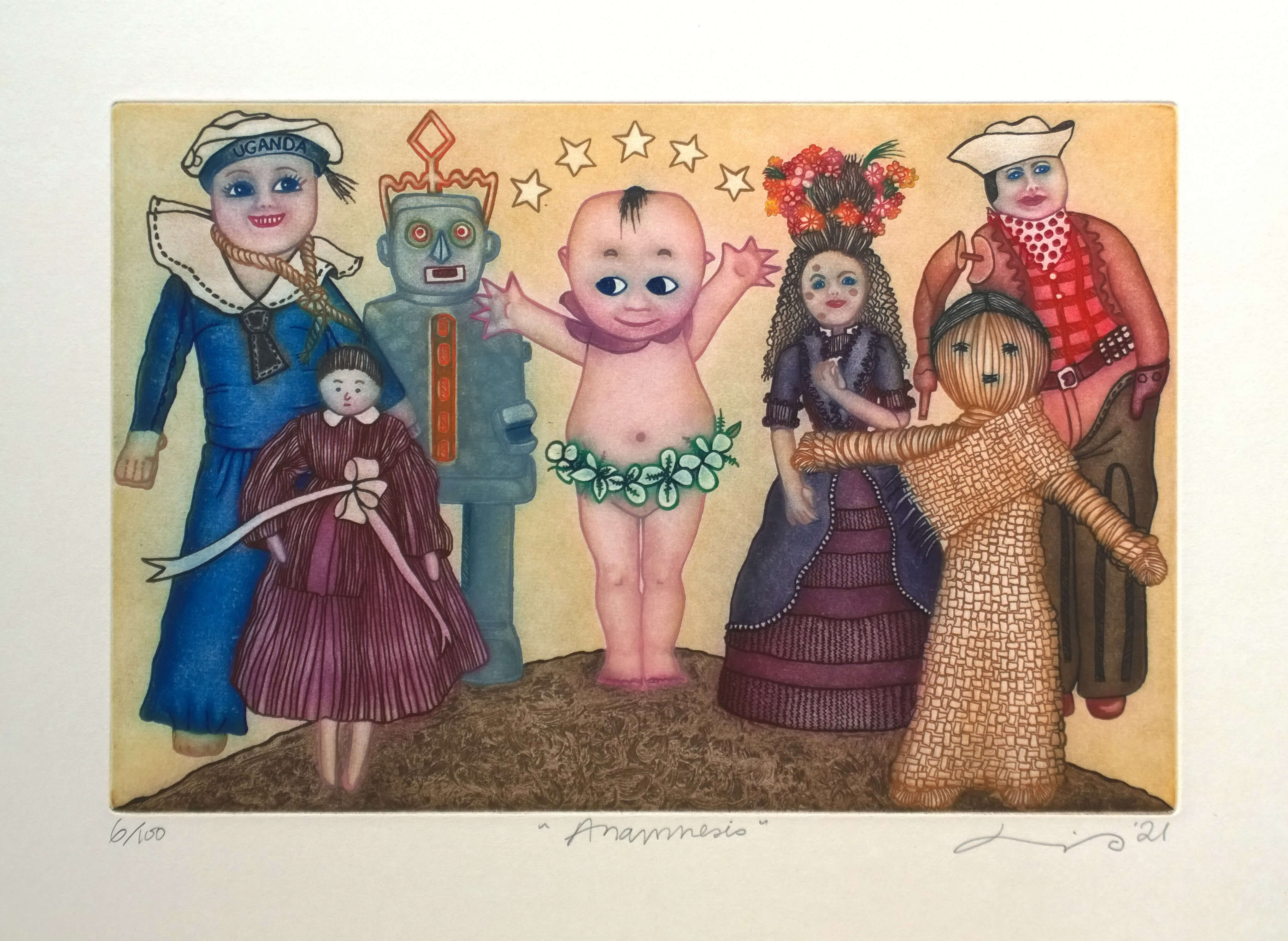
Images of childhood are employed as my visual language and the topics discussed have grown and changed throughout the years but are always from the perspective of a woman and mother, often feminist in nature. Currently the idea of recognising how difficult simply navigating a life path can be, drawing on Jung's writings and following this questioning thread back through time is being investigated. This particular image looks at the possibility of rebirth in different physical forms and into differing cultures. Steel plate, colour inked etchings are produced by applying all of the coloured inks in one go. This is a time consuming process which means bigger plates can take a whole day to produce just one print. Inks move and merge during the wiping down process which means no two prints are exactly the same, editions are limited and Fabriano paper is used.
Dianne Murphy, Anamnesis, 2021, Photography: Dianne Murphy, © Dianne Murphy

Symbiote is an explorative visual project about underground fungal networks -mycelium- in comparison with my own interconnected system of relationships and resources. Illustrated in the form of two maps, the piece opens up questions about systematic growth, selectivity, cooperation and dependence. All we can learn about the mesmerizing life of clonal organisms, such as fungi, can be applied in our thinking in order for us to develop not only our tools of communication technology, but our relationship with the natural environment and each other.
Emese Veszely, Symbiote, 2021, © Emese Veszely

An attempt to tell a story of a community at a church, without political judgment, without objections, an experimental film, not following the rules of classical drama, not showing great characters that we don’t need anymore. The daily life of the community of people who built a church together during comunism. Gymnastics, common room, choir, confirmation preparations, wedding preparations, group of people with disabilities. Observation of daily practices taking place around the unique place in which there is the moonstone. As a young person, I interact with the community, and to do that, I step away from the internet and go to church. The place is lovely, and I make no secret of the fact that I am very envious of the parishioners of the long-standing bonds they have formed, but I also feel a sense of dread there, due to the propaganda of the church authority as well. Also, the relationships of parishioners on a daily basis have proven to be very complicated. In my work I try to convey the strange feelings that are associated for me with the community.
Ewelina Węgiel, people from here, n.d., Film Still from Video (https://youtu.be/gTQxyguHCGE, 2:30min), Photography: Ewelina Węgiel, © Ewelina Węgiel

Staging a zoom-call with myself, I let splinters of me interact with each other. Versions of myself meet in the virtual room. Trying to form a connection, they can not seem to overcome the threshold separating them, their dialogues never meet. While one asks “Can you hear me?” another one negates, nods or informs the others of a lost signal. In the concrete world, the separation between them would be the flow of time that places them in a linear, consecutive order. In my video work “Can you hear me”, that notion of non-union is the digital. While it gives them the room to encounter free of the orders of time, the technical itself becomes a symbol of their separation.
Franziska Ostermann, Can you hear me?, 2021, Film Still from Videowok, Photography: Franziska Ostermann, © Franziska Ostermann

This year has inevitably divided us, we were not allowed to leave our city and this situation meant that we couldn't even see our family members, our fiancé or our closest friends. The proposed painting expresses a nostalgig reference to the life, more joyful and carefree, like we lived before Covid-19. In fact, in the painting called "innocent youth" we see two young people who smile amused and happy.
The Covid has strained our feelings, our sense of community, and the painting wants to examine this dreadful period.
Giada Rotundo, Innocent youth, 2020, Photography: Giada Rotundo, © Giada Rotundo

In a community you feel understood, you exchange ideas and have similar interests. I mainly use the Instagram community. Here, it's about spreading and using knowledge. I use it as a feedback platform. The digital world works globally. I am no longer surrounded by local barriers and can quickly exchange information with people all over the world. The pandemic has made the enormous power of the digital world much more present. Almost all processes have shifted to the digital world. I chose this digital work because the woman has two faces. Depending on the community, we have different faces, our behavior changes and so does our appearance.
Gigga Hug, Bodygrid double face, 2020, © Gigga Hug

Lost and Found is a photography project within the community I life in, found single gloves are collected, while recording not only the place and the time of the finding , but also a short description of the glove to enable recognition by its eventual owner. The glove is then photographed with neutral, two-sided lighting against a white background. The gloves are left as they were found. The photo is integrated into the archive with a consecutive number and the corresponding description of the find. The photos are uploaded to a instagram site @glovesfound and tagged with the location they were found at. The project plays with the idea of the transience of consumer products, but also tries to stimulate a dialogue within a community. The archive so far includes photographs from Germany, Lithuania and Spain, and the archive is constantly growing.
Gordon Endt, Lost and Found, 2020, Photography: Gordon Endt, © Gordon Endt

This is a digital collage which blends imagery from the 1918 Spanish Flu pandemic and climate change. Here we see nurses and stretcher bearers coming to the rescue of insects and spiders in a house that is filled with danger for the small creatures. The pandemic highlighted the effects for humans when the natural world is exploited and how we need to work together to make things better, to be part of a community where all animals are looked after and cherished.
Helen Grundy, They Die, We Die, 2020, © Helen Grundy

Sculpture portrait in marble (one piece), aurore (portugese marble) of young girl, my granddaughter.
Herman Benschop, Felien met krullend haar, 2019, Photography: Herman Benschop, © Herman Benschop

The series of small paintings with the title "jeder sonnenuntergang erzählt 1 story" accrued while the first shutdown was taking place. From one day to the next social life fell apart and the meaning of social media grew even bigger. The artist reflects on questions of individuality and time. The romantic subject of the sunset dragged from the digital interface to a raw surface of cardboard and dry oil. Stories vanish after 24h, the paintings stay, the sun rises up and down and the borders between the images dissolve.
Janica Irina Madjar, jeder sonnenuntergang erzählt 1 story, 2020, Photography: Janica Irina Madjar, © Janica Irina Madjar

The concept of my project directly related to the travel and self-realization of man in a globalized world. Also in my project, I juxtaposing theory of self-movement and philosophical theory of Plato's cave. Plato, which describes group of people that are the prisoners of the shadows: they live in a cave, made to see only shadows, which are the reflections of the fire light, but nothing else. Those are prisoners of the shadows existing in their own misconceptions about the reality. Those shadows are only the product of imagination, projecting mental state into the substance or objects. The other side of the truth is Sun, which is outside of the cave and everything in that world is the mere reflection of the Sun itself. According to Plato, the ultimate aim is to get to the light of the Sun, real truth, the higher reality, not its reflections.
I have been working on this project since 2016 and every year it continues to develop and fill with new conceptual meanings. Since the semantic basis of my project is directly related to movement and world trends, the events that take place fill its weight with deeper meanings. He was born as a response to events with a migratory crisis, and on several years later, based on studies of different cultures of the world he was to have a value philosophy. I continue my research and with the inclusion of more and more countries, my project continues to develop. Recent major life transitions which happened both globally in the face of pandemic and locally by the war situation triggered disorienting dilemma on a collective level challenging the poetry of day-to-day life with a sense of isolation, alienation, state of hopelessness. The project explores “conceptual maps” of both individuals and collectives’ perceptions of reality, which is in constant change and acts as a muse fall on thinking about fundamental questions: Are we only accepting the reality of the world presented to us ignoring other perspectives of the truth? Are we aware and capable of acknowledging the blurry line between virtual and real, visible and invisible?
Concept of my project refers to the problems arising in connection with the closing of borders due to the pandemic, to search the man's place in the global world, which suddenly narrowed to within the same country or even the region. I want to draw the viewer's attention to a paradox – closing, limitation offline and online boundless openness and links clearly manifested during a pandemic. Many places of the World, felt this situation in itself. The problem of the pandemic was joined by the unresolved problem of the migration problem, which has become aggravated throughout the world.
Main concept of my project based on notions "Movement = Change". This is an understanding of changes in the social environment, a person's place in a modern city; stratification and layering of various cultural, social changes. In addition, the project touches upon topics related to the pandemic, border closures and, of course, the growing global tendency to move away from globalization, the desire of states to self-identify, focus on internal problems, and internal self-development.
Kateryna Bortsova, Union – Communion, 2021, Film Still From Video, Photography: Kateryna Bortsova, © Kateryna Bortsova

This project is a testament to the model’s trust in the painter - not merely as an artist, but as someone who has the tools to express a shared situation, a person they trust with their story. Physics teaches us that seeing is touching. You cannot see an object without interacting with it. The same concept applies to expanding our intellectual and emotional knowledge by involving ourselves into other people’s ways of experiencing the world. In a drastic global climate of isolation and fear, I feel the time is right to offer these works about survival, grace, and connection.
Kristiana Cukaj, Twenty Ways to See the World, 2021, Photography: Kristiana Cukaj, © Kristiana Cukaj
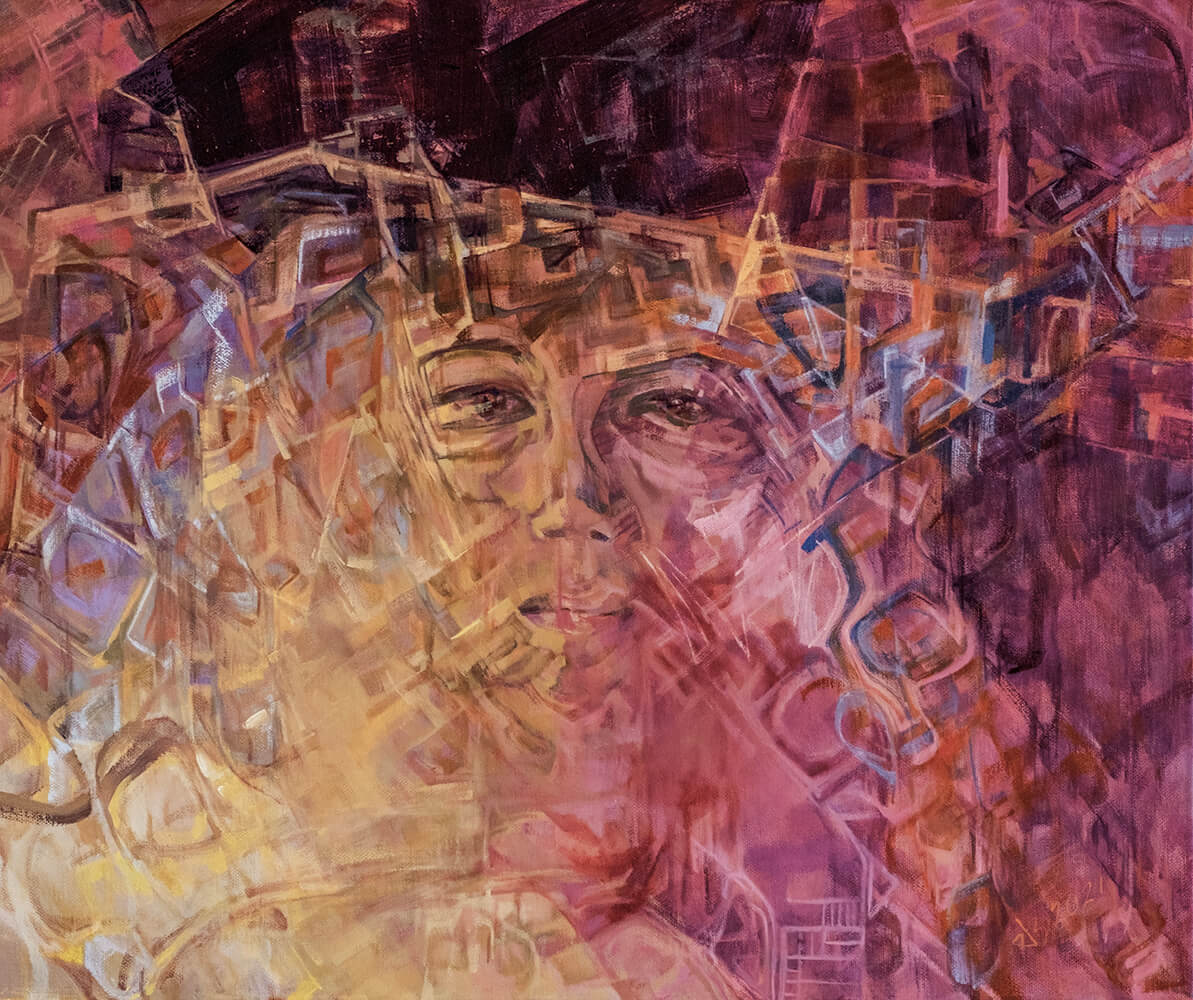
Inhabitants of a city share their vision of living. As a result, city development symbolizes what the community has done for survival, and this process is documented in maps.
Using fragments of maps of my hometown Hong Kong, this painting reflects the reminiscence of the local history and anticipation of our future from a first-person narrative. For reference, I employed both old and new maps of the Kowloon Peninsula, where 40% of the population resides. With vigorous colors and weltering brushstrokes, I intend to explore the nature of the existence of a community.
Kwong Kwok Wai, The Map of A Myth III, 2021, Photography: Yik Yeung Man, © Yik Yeung Man and Kwong Kwok Wai

Even before Covid-19, I've always had a missing sense of belonging to a local community. Maybe it's my introversion or the capitalist reality that propagates individualism and competition. Since the pandemic, I've had the chance to join digital communities in the form of recurrent hangouts, one example is a group of international women artists with a shared sense of camaraderie.
This work places recurrent sentences from correspondences in these new forms of communities against a backdrop of a local reality that shows houses of stranger neighbors, and a construction site of a new mall.
Lama Altakruri, You are invited, 2021, Photography: Lama Altakruri © Lama Altakruri

Last two years made us less nomadic and more home based. I use the ancient symbol of home in my artwork to emphasize this "new-old" importance, the meaning of the home and the family in these difficult days. At home with our best friends, the computers, we come in contact with our relatives and friends, we work, we communicate, we get acquainted, we like and dislike, we live. The symbolism of the letter "D" in the artwork – door, konowledge, hands – complements the importance of the home. Home and computers that's what's our community now.
Laura Dimitrova, Old-New Home, 2021, Photography: Laura Dimitrova, © Laura Dimitrova

The microcosm as part of an interaction with synaptic connections of the global-digital community.
Nature is a networked system and interacts directly. Fungi, for example, have micro-stimuli and synaptic capabilities with the goal of informing themselves and other plants and protecting themselves when threatened.
The subtle network can be a stimulus for us to nurture and expand community in real and virtual space.
A virtual immersive environment with direct interaction, allows us to expand a cross-cultural capacity to act.
maboart, universal decoding, 2020, Photography: maboart, © maboart
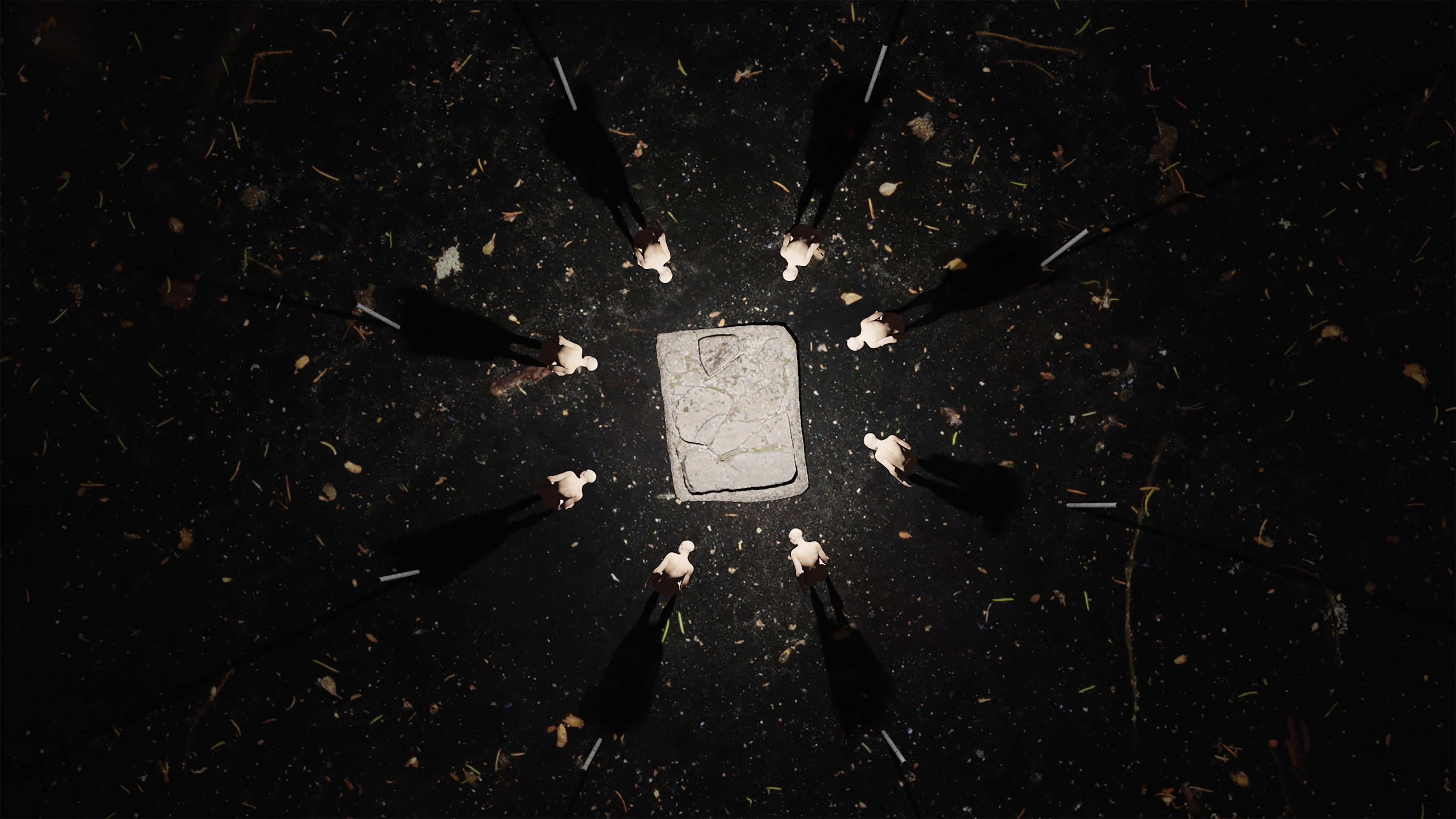
Community to me means to acknowledge and establish kinship with each other. Weaving a web, creating networks and connections between one and another, human or other entity, be it plants, animals or microbes. Especially in times like now, community is so important for survival. We need to learn how to communicate with each other, to understand ones perspective in order to create peace in a community. That process of communication, connection and repetition of cycles I explore in my work. My work is informed by books from Donna Haraway, Anna Tsing or Bruno Latour. They helped me to understand more deeply how processes are intertwined and connected.
Maksim Klopfstein, Rites, 2021, 3D Render: Maksim Klopfstein ©Maksim Klopfstein

I said I wanted to lick all my friends faces when this will be over. I got obsessed with gardening, I collected snails. A friend posted a picture of two snails making out. I posted one of more snails making out. He asked me if it was a response. It was.
Michal Florence Schorro, more love, 2021, Photography: Michal Florence Schorro, © Michal Florence Schorro

The world is moving faster. Communication gets more and more digital. Google translator will help you to survive in a foreign community and collaboration with different countries gets more and more easier. I decided to apply with this work, because this photo series was the most intense experience of collaboration with foreign people for me. Back then, I was visiting Sarajevo to interact with the people there: I wanted them to be a part of an open "performance." The huge problem was a missing internet connection and also my missing knowledge in the Serbian language. Despite the difficulties, the people in Sarajevo were helpful, open minded and even offered me to eat with them (with themselves only having some euros left). For me, this experience symbolizes the most trustworthy and pure connection a society can have.
My definition of a digital community is an easier, but mostly also a more superficial connection with people all over the world. During the last year(s), the interaction in digital communities rose up. You can easily get in touch, but can also easily judge people by only knowing their digital representation in the digital community. The ability to present yourself and your work to the world comes with advantages and disadvantages, but I strongly believe that if people start working together with the same responsibility as if in the "real-life" communities, the connection has a lot of potential.
Michelle Mall, Sarajevo Performance #1, 2015, Photography: Michelle Mall, © Michelle Mall

Axon (from Greek ἄξων áxōn, axis) is an algorithm based art project that explores visual patterning evolving through coincidence and imperfection by being in a constant state of renewal and development. Inspired by collective connectivity in human relationships, these movements of sequencing visually represent an abstraction of identity and memory in motion. All creations are a reflection of its creator, and the machine simulates human behavior in its process. The interactive, cooperative nature between humans creates a hive-like dynamic that I am interested in.
Based on these findings, Axon explores human-technology in correlation within the digital realm. This reveals a visual syntax defined by movement at high levels of intensity as the interconnections of a community shift rapidly. My artwork reflects on these collective environments through a collaborative effort. Inspired by the exploration of these research, I share my creative process with artificial intelligence, allowing the spontaneous and flawed to happen without any rules. Through my exclusive approach; an intuitive narrative forms to exist in constant symbiosis with an algorithm.
Nero Cosmos, Axon, 2021, © Nero Cosmos

Last year was the first time I felt strongly like there is a big lack of community in our society. As always when there is power and fear involved, people divide into 'the good' and 'the bad' ones. I definitely belonged to the latter mentioned, since I tend to question information. I'm used to travelling and meeting new people. It was obviously harder last year. Eventually, I turned more and more to social media, to interact with people and share photographs on a regular basis. But it will never be the same as meeting someone in reality. My photograph features my sister and fellow traveler, who was my community through last year. This photograph is shot during our first trip together after travelling became easier.
Nike Ossler, Blue is the warmest colour, 2021, Photography: Nike Ossler, © Nike Ossler

I filmed "The Island", during a painting residency I did last summer in Saint-Rémy-de-Provence. The abbey of Saint-Roman built in the 5th century located inside the caves reminded me of the secluded life we had during the residency and the isolated process of creation. In this video, I am evoking the caves' layers of history and imagine the life of the hermits, their beliefs, doubts, rituals and thoughts.
Paulius Sliaupa, The Island, 2021, film still from video (https://youtu.be/IyIy9pgAB14), Photography: Paulius Sliaupa, © Paulius Sliaupa
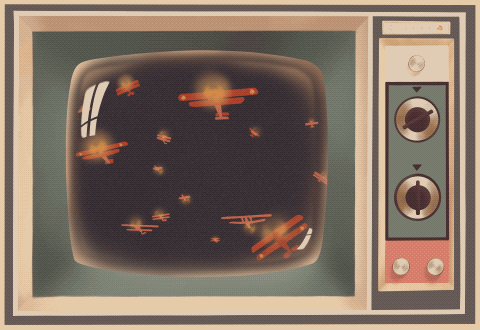
I am a crossover artist, who was dedicated to studying sculpture and oil painting. Now I like to create digital engravings on my iPad. An iPad is a maternal container that can hold my unconscious imagination, and can remove the barriers of physical materials and the space. It allows me to project my inner world on the screen in a direct way, at any time and place. Also, it can reflect my inner self soon, by means of which I could turn my unconscious meditation to thoughtful expressions. Oftentimes, a painting is regarded as a non-verbal symbolization, and further it is viewed as a non-physical object. To me, though, it is more like the touch of nature in an oasis, which provides the artist with new raw materials of the new world.
This is an NFT work which is called The Old Millennium, when God deemed appropriate, devoted itself in the salvation of a new.
Qixuan Wu, The Old Millennium, film still from video/gif, © Qixuan Wu

The spectator of the show moves into the central open space to "soak/drown" in Indian artist-environmentalist Roma Madan-Soni’s 3-meter-tall light-based sculptural installation, Water Drops on Coral (2019), a dialog/intervention on the marine ecosystem of the Gulf. The work is not just about "getting back to nature" (Roth, 1973, p. 94); it voices and initiates nostalgia for the spectatorship of the real landscape that once existed, beyond this enclosed exploratory/illusory space. “It’s like a yearning for the unspoiled paradise garden, the Eden” (Tuchman 1971, pp. 118-126). The viewer canters from the surface of the ocean to its depths through the underwater caverns and grottos interrelating with the kaleidoscopic breathing womb of the ecosystem, a "shared environment" all-pervading within and with-out the reefs of the cyclical intervention. The upper cone-shaped drops irradiate the brilliant images of the underwater reefs, and the marine flora and fauna that nestle within them. They are encapsulated by the penetrating blues and greens of the Arabian Sea; safe in their mother’s womb. The darker-narrower lower drops are iconic of the pollution and damage caused by negative human intrusion, the acidified waters impregnated by oil spills, and excessive plastic. They destroy the reef in the depths of the sea and thereby, the biodiversity that resides within its folds. The wreckage at the bottom of the artwork comprises of worn-out tires, debris and ghost fishing nets, trapped within which the marine species are enmeshed and ensnared to death, similar to the aftermath of unconsented women’s penetrated bodies, war and violence.
Roma Madan Soni, Water Drops on Coral (Sculptural Installation), 2019, Photography: Manoj Soni, © Manojksoni and Roma Madan Soni

There is this amazing space before thoughts and feelings turn into words, that, inevitably, limit them. It’s a magical space from which arise pure thought and emotion through which we grasp things before we rationalise them. That is how sensation can be metabolised without putting a verbal tag on it. One needs courage to look at things as a witness rather than an immediate manipulator, to hold that space between the birth of a sensation and its interpretation. That space of seeing before naming is magical; it is liberating, pure and honest. It is magnificent because it is individual, very-very individual. No one can take it away from you or describe it for you. It doesn’t belong to anyone or anyplace or any rules or any books until we reduce it to a verbal form. Today, most communities are digital, why? I don’t think most of the people can answer to that! Because they don’t know. Because they have been driven to it. Digital communities intended to tag that space in order to be understood with most. In order to be perceived by most to fulfill their intentions. I appreciate digital communities only if we don’t allow ourselves to forget about the organic communities. These are the thoughts encapsulated in my painting.
Roshanak Khalilian, them ALL – that space!!!, n.d., Photography: Roshanak Khalilian, © Roshanak Khalilian

Heydt's layered imagery conflate time and place, colliding and merging generations of possibilities, and disrupting logical relationships between occurrences. Combining images of destruction with portrayals of the virtues born from the American Dream, Heydt confronts the disillusionment of our time with the ecological and existential nightmare it is responsible for.
Sam Heydt, Saliva Heterotopia, 2021, Photography: Sam Heydt, © Sam Heydt

"Happy to Serve You (Hedonalgia)" is a new installation that features historical symbols, advertisements, mass culture references and BDSM toys and unpacks a collection of cultural influences that relate to the struggles and plight of contemporary Greek society. Spanning between hedone (pleasure) and algos (pain), this piece examines both the humorous and the tragic side of the "Greekness hell loop", the monetisation of a culture that is deeply reliant on its unique values, strong character and its rich mythological and historical past and at the same time depends on tourism and foreign investment in order to function.
Tahume, Happy to Serve You (Hedonalgia), 2021, Photography: Tahume Duo, © Tahume Duo

Celestial Navigations is a project exploring community and investigates models of interconnectedness. Inspired by a student on the autism spectrum, the interactive piece was created at the Arts Council public building in College Station, Texas, with a goal to explore intuition and youth in relation to community. Drawing with chalk can be associated with childhood expression and outlining a human body at a crime scene. People were encouraged to scribble carelessly or outline themselves with a helping hand to find answers to the complex questions of existence and everyday life.
Trevor Coopersmith, Celestial Navigations, 2021, Photography: Kassandra Maduzia, © Trevor Coopersmith

In the work, multiple blobs of paint with small white eyes are fed into an artificial intelligence algorithm. The resulting digitally created paintblobs are then composed into a video loop. In the work, we see how these humanoid paintblobs meet and grow, change and dissappear like the ideas of a community or a culture, that inspire and influence each other, some grow, some diminish, and they all are equally important in their existence.
Trygve Skogrand, The Interchange of Ideas, 2021, film still from video, © Trygve Skogrand

The Waggle Danse is a term used of bees for communication: enrichment of life.
Unkraut Sarah Kreuter, Waggle Danse, 2021, Photography: Sarah Kreuter, © Unkraut Sarah Kreuter

My pleading for renewable energies thinking about the climate change in progress caused by mankind and fossile emissions. Extreme weather as result of the climate change is symbolized by a tornado just hitting the cooling tower of a coal power station whose emissions are killing the climate. The only way out are renewable energies.
This semi-abstract oil painting received a "Merit Award" from Art ROOM Gallery (Toronto Canada) in the "Life on Earth" Art Exhibition in December 2020. The original artwork, created and painted by me – Volker Mayr – in oil on stretched canvas is titled, dated and signed on the back.
Volker Mayr, Climate Change, 2019, Photography: Volker Mayr © Volker Mayr Artworks

Dancers can use their bodies to express their minds in space.
The sight reminds me that I also have a desire to dance and rediscovers the beauty of human form.
Yumi Takeuchi, Dancer, 2019, Photography: Yumi Takeuchi, © Yumi Takeuchi
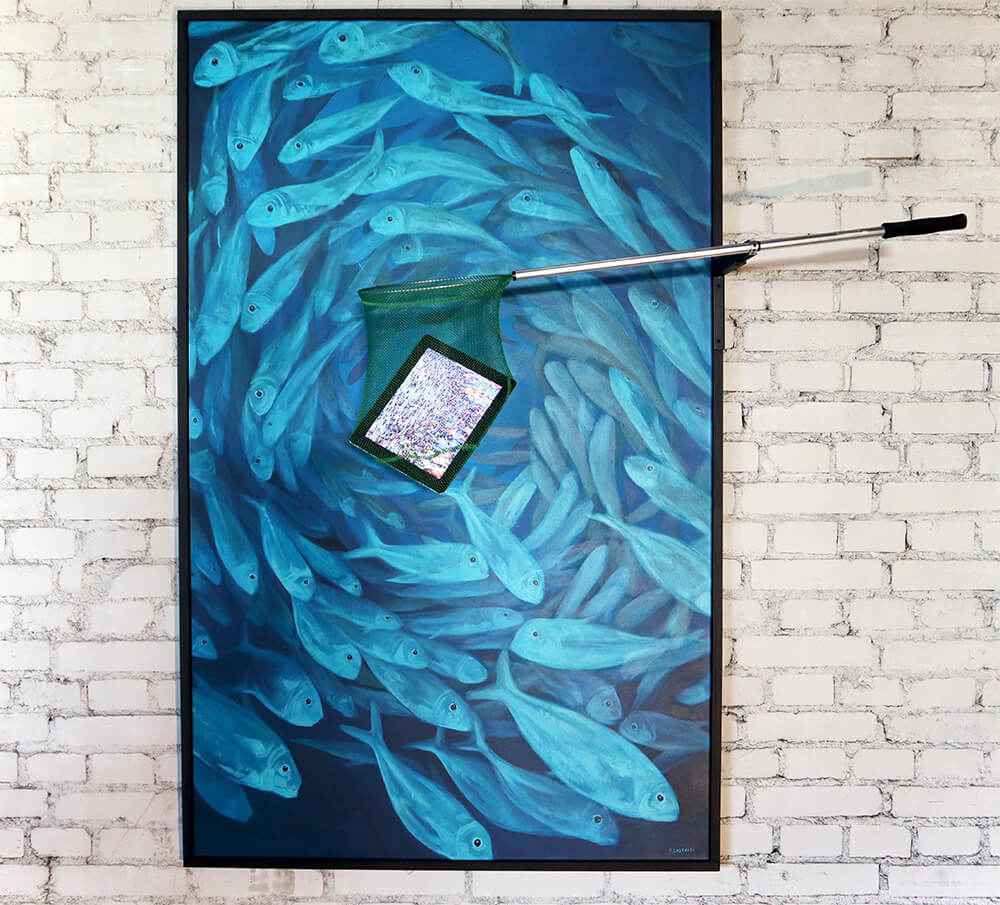
The picture shows a school of fish in a circular formation.
A fishing net protrudes into the picture from the right side.
At the level of the water circle in the center of the shoal lies an iPod in the net.
On the iPod a video collage with various swarm intelligent creatures and life forms is shown in an endless loop.
The metaphor to the shoal, in this case the snapshot (photo).
Crowd of people on the beach.
The video-in-picture installation is intended to encourage people to use the global network and to search for intelligent solutions in the digital community for the care and salvation of our blue planet.
Yvonne Lustrati, Deep together, 2021, Photography: Yvonne Lustrati, © Yvonne Lustrati
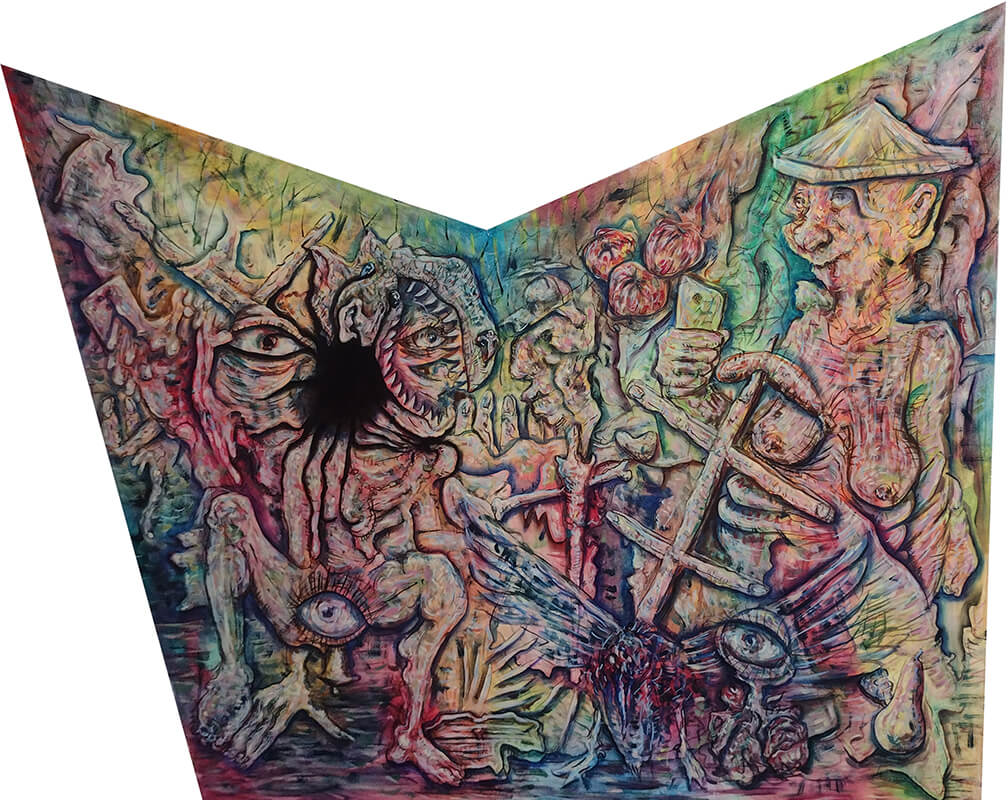
Social media, technology, the Internet, and smartphones provide opportunities for communication and development unprecedented in the history of mankind. How is it possible, as the research clearly shows, people, especially young people, are less and less able to express their emotions and communicate with the rest of society? How is it possible that in the moment of constant communication with the world, we feel alone. The number of depressed and even suicidal people is increasing drastically? Perhaps we are biologically herd, highly intelligent animals that are not quite able to relate to today's world of apparent freedom.
Ziemowit Fincek, Vision with social media and a black hole, 2021, © Ziemowit Fincek